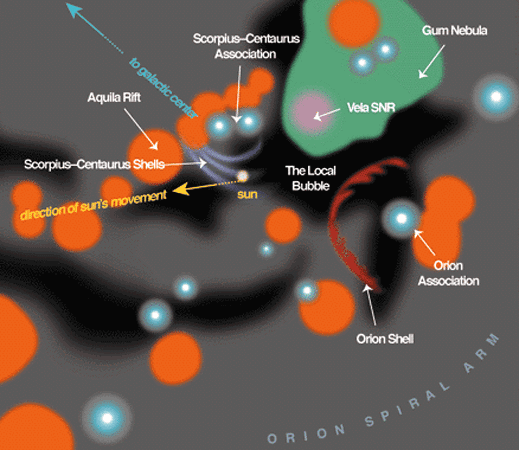Find out the latest thinking about our universe.
-
bystander
- Apathetic Retiree
- Posts: 21577
- Joined: Mon Aug 28, 2006 2:06 pm
- Location: Oklahoma
Post
by bystander » Tue Feb 09, 2010 3:37 pm
A new 3D map of the interstellar gas within 300 parsecs from the Sun
Astronomy and Astrophysics - 2010 Feb 09
Astronomy & Astrophysics is publishing new 3D maps of the interstellar gas in the local area around our Sun. A French-American team of astronomers presents new absorption measurements towards more than 1800 stars. They were able to characterize the properties of the interstellar gas within each sight line.
This week, Astronomy & Astrophysics publishes new 3D maps of the interstellar gas situated in an area 300 parsecs around the Sun. A French-American team of astronomers presents new measurements of the absorption by the interstellar gas in the Sun's local area. Knowledge of the interstellar medium properties, including the spatial distribution, dynamics, and the chemical and physical characteristics, allow astronomers to better understand the interplay between the evolution of stars and their exchange of matter with the ambient interstellar medium. The local area around our Sun has been studied with many surveys at various wavelengths, but the whole picture is still far from being either complete or fully understood.
-
neufer
- Vacationer at Tralfamadore
- Posts: 18805
- Joined: Mon Jan 21, 2008 1:57 pm
- Location: Alexandria, Virginia
Post
by neufer » Tue Feb 09, 2010 4:19 pm
http://www.aanda.org/content/view/438/42/lang,en/ wrote:
___ Map of the interstellar gas within 300 parsecs
 Map of partially ionized interstellar gas within 300 parsecs around the Sun, as viewed in the Galactic plane. Triangles represent the sight-line positions of the stars used to produce the map. White to dark shading represents the low to high values of the gas density, and orange shading is for areas with no reliable measurement. The Local Cavity/Bubble is shown as the white area of low density gas that surrounds the Sun at about 80 parsecs.
Map of partially ionized interstellar gas within 300 parsecs around the Sun, as viewed in the Galactic plane. Triangles represent the sight-line positions of the stars used to produce the map. White to dark shading represents the low to high values of the gas density, and orange shading is for areas with no reliable measurement. The Local Cavity/Bubble is shown as the white area of low density gas that surrounds the Sun at about 80 parsecs.
http://en.wikipedia.org/wiki/Local_Fluff wrote:
<<
The Local Interstellar Cloud, casually called the Local Fluff, is the interstellar cloud (roughly
9 parsecs across) through which the Solar System is currently moving. The Solar System entered the Local Interstellar Cloud at some time between 44,000 and 150,000 years ago and is expected to remain within it for another 10,000 to 20,000 years. The cloud has a temperature of about 6000 °C, about the same temperature as the surface of the Sun. It is very thin, with 0.1 atoms per cubic centimeter; approximately one-fifth the density of the galactic interstellar medium (0.5 atoms/cc) and
twice that of the gas in the Local Bubble (0.05 atoms/cc), the Local Bubble being an area of low-density in the interstellar medium, with
the Local Cloud a small, more dense area. The cloud is flowing outwards from the Scorpius-Centaurus Association, a stellar association that is a star-forming region. The cloud formed where the Local Bubble and the Loop I Bubble met. The Sun, with a few other local stars, is embedded in the
Local Fluff. The Local Interstellar Cloud's potential effects on Earth are prevented by the solar wind and the Sun's magnetic field.>>
Art Neuendorffer
-
neufer
- Vacationer at Tralfamadore
- Posts: 18805
- Joined: Mon Jan 21, 2008 1:57 pm
- Location: Alexandria, Virginia
Post
by neufer » Fri Feb 12, 2010 2:36 am
http://www.solstation.com/stars/sol.htm wrote:
<<In recent millenia, the Sun has been passing through a Local Interstellar Cloud (LIC) that is flowing away from the Scorpius-Centaurus Association of young stars dominated by extremely hot and bright O and B spectral types, many of which will end their brief lives violently as supernovae. The LIC is itself surrounded by a larger, lower density cavity in the interstellar medium (ISM) called the Local Bubble, that was probably formed by one or more relatively recent supernova explosions.
As shown in a 2002 Astronomy Picture of the Day, located just outside the Local Bubble are: high-density molecular clouds such as the Aquila Rift which surrounds some star forming regions; the Gum Nebula, a region of hot ionized hydrogen gas which includes the Vela Supernova Remnant, which is expanding to create fragmented shells of material like the LIC; and the Orion Shell and Orion Association, which includes the Great Orion Nebula, the Trapezium of hot B- and O-type stars, the three belt stars of Orion, and local blue supergiant star Rigel.
Art Neuendorffer

